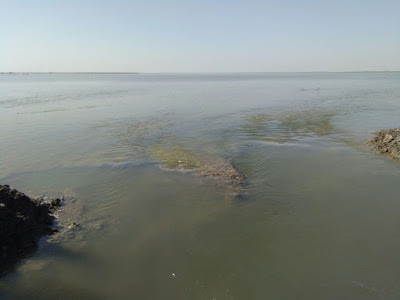The Gujarat government does not miss a single opportunity in praising itself for its ambitious Narmada project or the Sardar Sarovar Dam. Expenses behind this project have increased by many fold, yet, the fact is, in many parts of the state’s farmers are waiting to see Narmada water reaching their farms.
The question is, if water does not reach farms, where does water go? If you ask this to the poor agariya, who farms salt in the Little Rann of Kutch, in a huge expanse about 100 kilometres north-west of Gandhinagar, Gujarat capital, his answer would be simple: It is being thrown away in the desert of Kutch.
 This answer may seem ridiculous, as Gujarat has always fought for raising the height of the dam, with the aim to collect and store more water.
But if you visit the Rann from October to May, you will see crores of litres of Narmada water is thrown in the salty desert every day from three corners of the Rann, Kuda, from Radhanpur and from the upper parts of Ghatila.
The Rann is a mud desert with nearly 5,000 sq km area, and various rivers like Banas, Rupen and Saraswati meet here, instead of the sea. More than 8,000 agariya families migrate and reside here for eight months and farm crystal, earth salt called “vadagaru” or poda salt. Salt farming in the Rann has a history of 600 years.
When Narmada water is released in the Rann, it washes away their salt farms, leading to a situation of manmade disaster. Recently, in the heat of elections, huge quantities of water were released from the Kuda minor canal of Narmada in Surendranagar district. The water released was continuous and, obviously, to please the farmers, as elections were approaching.
 However, farmers could not use much of the water during that period, and the rest of the water was then released into the Rann. It washed away 150 salt farms completely, while an equal number got partially affected.
Each of the salt farmers had spent around Rs 1 to 1.25 lakh by taking advance from traders with the promise to sell salt. However, due to this calamity, caused by Narmada water, they have now returned to their native village, leaving the Rann.
“We have to compromise for the next year’s price, as neither will we be able to pay the advance amount, nor will be able to farm any salt”, Dhirubhai, one of the affected salt farmers, said.
Agariyas represented to the district collector, Surendranagar, as well as at the Sardar Sarovar Narmada Nigam Ltd (SSNNL), the state agency responsible for the Narmada project in Gandhinagar.
 “Every time, the Narmada department has the standard oral reply: Farmers demand for water, and we are asked to release water in canals, we do what we are asked to do”, said Harinesh Pandya, trustee, Agariya Heet Rakshak Manch, the non-profit organization working among salt farmers.
“However”, he added, “As per the rules of operation of Narmada canals, the department has to calculate the water requirement and release it accordingly considering the carrying capacity of the canal. They want to portray this as an agariyas versus farmers issues.”
“The construction of canals is very weak and they can’t carry the load of water. Whether we demand water or not, the engineers release water from the canal’s siphon to save the canal from getting damaged”, Keshubhai, a local salt farmer reasoned.
“Narmada water has become a big disaster for us. The government is not bothered about agariyas as we are scattered in four districts”, he added.
It has a human rights and environmental angle, too. The sudden release of water caused the death of pregnant women two years ago in the Rann. The Rann is also Wild Ass Sanctuary, where such irresponsible act of the Narmada department can cause irreversible loss of an extinct species.
Meanwhile, the salt industry and the Narmada department have begun to survey the Rann areas, even as water is still being released from another side– Maliya. Unless there is some permanent solution to harvest this water on the periphery of the Rann and distribute it to the areas where it is actually required, the life of agariyas and wild asses in the Rann will be at risk
|